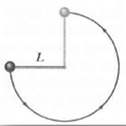Figure shows a ball with mass m = 0.341 kg attached to the end of a thin
Question:
The rod is held horizontally as shown and then given enough of a downward push to cause the ball to swing down and around and just reach the vertically up position, with zero speed there. How much work is done on the ball by the gravitational force from the initial point to?
(a) The lowest point,
(b) The highest point, and
(c) The point on the right level with the initial point? If the gravitational potential energy of the ball - Earth system is taken to be zero at the initial point, what is it when the ball reaches (d) the lowest point, (e) The highest point, and
(f) The point on the right level with the initial point?
(g) Suppose the rod were pushed harder so that the ball passed through the highest point with a nonzero speed. Would ˆ†Ug, from the lowest point to the highest point then be greater than, less than, or the same as it was when the ball stopped at the highest point?

Step by Step Answer:

Fundamentals of Physics
ISBN: 978-0471758013
8th Extended edition
Authors: Jearl Walker, Halliday Resnick





